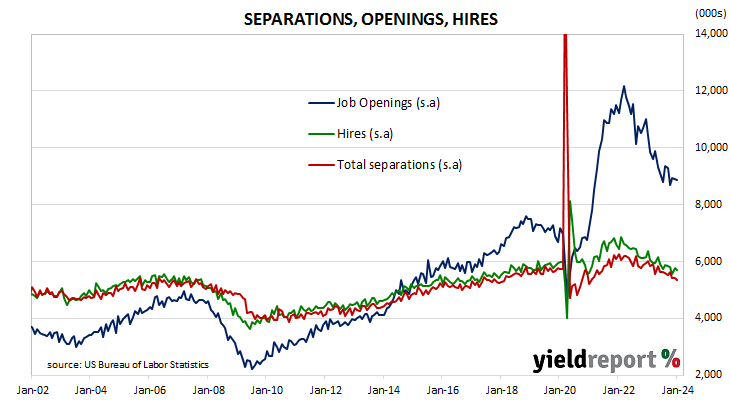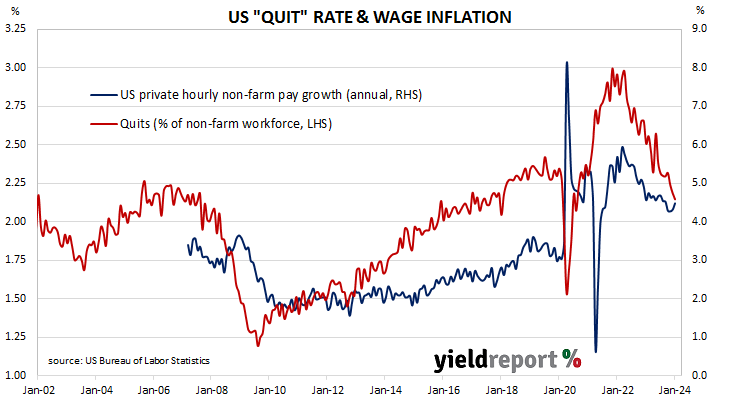Summary: US quit rate declines to 2.1% in January; ANZ: trend of jumping jobs for higher pay has subsided; short-term US Treasury yields up a little, longer-term yields down; expectations of Fed rate cuts in 2024 soften; fewer quits, separations, openings.
The number of US employees who quit their jobs as a percentage of total employment increased slowly but steadily after the GFC. It peaked in March 2019 and then tracked sideways until virus containment measures were introduced in March 2020. The quit rate then plummeted as alternative employment opportunities rapidly dried up. Following the easing of US pandemic restrictions, it proceeded to recover back to its pre-pandemic rate in the third quarter of 2020 and trended higher through 2021 before easing through 2022 and 2023.
Figures released as part of the latest Job Openings and Labor Turnover Survey (JOLTS) report show the quit rate declined in January. 2.1% of the non-farm workforce left their jobs voluntarily, down from 2.2% in December. Quits in the month fell by 54,000 while an additional 353,000 people were employed in non-farm sectors.
ANZ economist Madeline Dunk said, “…the trend of jumping jobs for higher pay has subsided.”
Short-term US Treasury yields crept a little higher while longer-term yields fell. By the close of business, the 2-year Treasury bond yield had inched up 1bp to 4.56%, the 10-year yield had lost 2bps to 4.11% while the 30-year yield finished 3bps lower at 4.24%.
In terms of US Fed policy, expectations of a lower federal funds rate in the next 12 months softened a touch, albeit with several cuts still factored in. At the close of business, contracts implied the effective federal funds rate would average 5.325% in March, essentially in line with the current spot rate, 5.32% in April and 5.175% in June. February 2025 contracts implied 4.31%, 102bps less than the current rate.
The fall in total quits was led by 45,000 fewer resignations in the “Health care and social assistance” and “Retail trade” sectors while the “Accommodation and food services” sector experienced the largest gain, rising by 51,000. Overall, the total number of quits for the month decreased from December’s revised figure of 3.439 million to 3.385 million.
Total vacancies at the end of January decreased by 26,000, or 0.3%, from December’s revised figure of 8.889 million to 8.863 million. The decline was driven by a 170,000 loss in the “Retail trade” sector while the “Accommodation and food services” sector experienced the single largest increase, rising by 94,000. Overall, 9 out of 18 sectors experienced fewer job openings than in the previous month.
Total separations decreased by 78,000, or 1.4%, from December’s revised figure of 5.419 million to 5.341 million. The fall was led by the “Health care and social assistance” sector where there were 86,000 fewer separations. Separations decreased in 11 of the 18 sectors.

The “quit” rate time series produced by the JOLTS report is a leading indicator of US hourly pay. As wages account for around 55% of a product’s or service’s price in the US, wage inflation and overall inflation rates tend to be closely related. Former Federal Reserve chief and current Treasury Secretary Janet Yellen was known to pay close attention to it.


